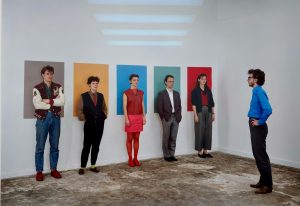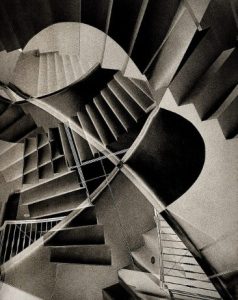‘עַל פֵּרוּק הַמִּישׁוֹר’ תערוכתו של יאן טיכי, יפה, מדויקת ומצליחה להנכיח חללים של מהות. היא נוגעת ברציונליזם,מודרניזם ואוטופיה, ובשכבות של תולדות האמנות מהריבוע השחור (והלבן) של מלביץ ועד דן פלווין. יש בה מעט התרחשות, אין בה רגע מסוים בו הנשימה נעתקת. טיכי יצר במרחב הגלריה דממה סמיכה הופכת למקום להתעמקות, לאבחנות, להתבוננות.

בחלל התחתון סדרת עבודות הדפס רשת על נייר ועבודת הוידיאו Cricket (2015), המציגה משחק קריקט במגרש החניה העירוני שמול הגלריה. בביקור בשבת בבוקר, שעה שנערך בחוץ משחק , נדמה היה לרגע שמדובר בהקרנה שלו בזמן אמת על המסך שבפנים.

Cricket, 2015,
Video, Single channel,
54:00 min
המשחק, כך מתברר, הוא כבר מסורת מקומית של תושבי השכונה,שתועדה על ידי טיכי. העבודה שאורכה שעה, עוברת בין שעות אור לחושך, מתעדת מעגל של שינוי. היחס בין העבודה להדפסי הרשת מעניינית: בעוד Cricket היא עיסוק בקונקרטי, במחוספס ובחי, ההדפסים עוסקים בשאלה תיאורטית ,מתמטית של כיסוי משטח.

חמשה עשר ההדפסים מראים את האפשרויות להרכבת מישור רציף ממחומשים. המחומש הוא היחיד מבין המצולעים שמאתגר ליצור ממנו לריצוף אחיד של המישור, ואיתור תצורות אפשריות הוא בבחינת חידה מתמטית. בטקסט התערוכה נכתב שחמש הראשונות התגלו על ידי המתמטיקאי גרמני קרל ריינהרדט (Karl Reinhardt) ב-1918, והתצורה החמש עשרה, אותרה השנה בעזרת מחשב. נכתב גם שטיכי השתמש בצבעוניות העבודות בסולם הצבעוני שגובש 1939 על ידי האמן אנסל אדמס (Ansel Adams) שיצר מדרג שאפשר לצלמים להחליט מראש על חשיפות שהביאו לצבעוניות רצויה בתצלומים. גם למי שכמוני, אינם מצויים ברזי המתמטיקה וההשתמעות של הגילוי הרי העובדה שיש מצולע שנדירות האפשרויות ליצור ממנו משטח מפתיעה. הסירוב של הצורה מעלה על הדעת התנגדות לכיסוי, להסתרה, להסדרה כאילו ביקשה הצורה הגיאומטרית לחרוג משורה דמיונית ממושמעת ולהציע אופציה אחרת. השימוש בסולם האפורים שנועד לחזות תוצאה סופית לשלוט בחומק מוסיפה להקשר שיוצר טיכי בין מודרניזם לגעש שמבצבץ מתחת לארשת השקט.
ההדפסים בשחור לבן ואפור מזכירים אופ ארט (וסרלי, ברידגט ריילי ואחרים), ונראים כעקבות גלגלים בקרקע, או אולי כחתך ביולוגי כלשהו. הגופים שמרחפים על הנייר והופכים לאבסטרקטיים כשם שמוסיקה היא אבסטרקטית, חומקת , חד פעמית. בפרפראזה על האפוריזם של הֵרַקְלֵיטוֹס (“אינך יכול להיכנס לאותו הנהר פעמיים”) הרי מוסיקה, וגם אמנות איאפשר לראות פעמיים, וודאי שלא את העבודות הדוממות רוטטות של טיכי. המרחק, שנדמה תחילה רב, בין המודרניזם המאופק של העבודות לוידיאו המשחק הולך ומצטמצם כשההבנה שטיכי מראה שתי מערכות חוקיות, שמשמרות את מקומן סמוך לקו הגבול בין המוסדר לתוהו הולכת ומתחוורת.

מרחב הבין לבין, על הכמעט, על הצפון והטמון והתוסס הופך לכמעט מוחשי בקומה העליונה. מיצב מס. 26 (2015) מורכב מעבודת אור הנעה על החלל כולו כך שקירות משתנים באמצעות תאורה משחור לאפור ללבן, ועל הרצפה חלות הצטלבויות וחפיפות שיוצרות צורות המזכירות תצורות גיאומטריות ואדריכליות. שישה הדפסי שקע על נייר לבן מראים שש אפשריות להרכבת מישור ממחומשים, כמספר המתמטיקאים שגילו את חמש עשרה האפשריות המוצגות בחלל התחתון. הדפסי השקע מתגלים בחלקים השונים של החלל כשהאור מוקרן לכיוונים.
כוחו של המיצב, באיכויות מיסטיות רליגיוזיות המזכירות את העבודה של דן פלווין Dan Flavin בעבודות אור הניאון. טיכי לוקח את הצופים למסע במישורי ריק, למקום בו קשב ודריכות הולכים ומצטללים לדיוק כמו זה שיוצר קולן (tuning fork ) בכיוון כלי נגינה.*
*אנקדוטה כרונולוגית היא שהתקינה של צליל אליו מכוון הקולן (440 הרץ) נקבע על ידי ועדה בינלאומית ב 1939, אותה שנה בה נוצר מדרג האפורים של אדמס, כאילו היה החיפוש אחר דיוק קודח במקביל כניסת העולם לתוהו של מלחמת העולם השנייה.
גלריה חזי כהן, רחוב וולפסון 54, תל אביב
הרשמה לניוזלטר הפירסומי השבועי של “החלון” בנושאי אמנות, אירועים ותערוכות חדשות – www.smadarsheffi.com/?p=925 (הרישום נפרד מהרישום לבלוג )
Jan Tichy / On the decomposition of a plane
Jan Tichy’s exhibition On the decomposition of a plane is beautiful, precise, and succeeds in concretizing space. The exhibition touches upon issues of rationalism, modernism and utopia, as well as layers of art history, from Malevich to Flavin. Tichy has created a place for contemplation and close observation.
The gallery’s lower space displays Tichy’s series of silkscreen prints on paper and the video Cricket (2015), depicting a cricket game held in a parking lot opposite the gallery. Watching the video inside on a Saturday morning, while the game went on outside, seemed for a moment to be a real-time screening. The game is a neighborhood tradition, documented by Tichy. The one-hour video transitions from light to dark, a cycle of change. Cricket is engaged in what is concrete, rough and alive, while the prints address a theoretical mathematical problem on covering area.

The 15 prints show options for a continuous plane composed of pentagons. Identifying new configurations is a mathematical enigma, with the pentagon the most challenging figure in this problem. The gallery text states that German mathematician Karl Reinhard discovered the first five configurations in 1915; number 15 was identified this year with computer assistance. Tichy also used the grey scale formulated in 1939 by the American photographer Ansel Adams, who designed it scale to help photographers decide on the exposure which would produce the desired result.

Cricket, 2015,
Video, Single channel,
54:00 min
The pentagon’s “reluctance” suggests an objection to concealment, as if it wished to stand out and propose a different option. Adding the notion of a scale designed to foresee the final result adds to the Tichy’s context between modernism and the volcano underneath the calm.
The prints are reminiscent of Op Art (Vasarely, Bridget Riley and others), and seem like tire prints or a biological slide. The figures hover over the paper to become abstract, in the same way that music is abstract and elusive with a single occurrence. To paraphrase Heraclitus, it is impossible to see art twice, especially not Tichy’s vibrating silent prints. The seemingly vast distance between the restrained modernism of the prints and the video gradually dissolves as we realize that Tichy is showing two systems maintaining their place near the borderline between order and chaos.

The in-between space becomes almost concrete in Installation No. 26 (2015) a light work moving across the entire space of the upper gallery floor, with the walls changing from black to grey and white. The lighting creates intersecting and overlapping shadows which generate geometric and architectural forms. Six intaglio prints on paper show six options of composing a plane made up of pentagons, the same number as the six mathematicians who discovered the 15 possibilities displayed in the lower level.
The power of the installation lies in its mystical religious qualities reminiscent of Dan Flavin’s neon works. Tichy takes viewers on a journey over planes of emptiness, to a place in which attention and readiness are pulled tighter and tighter into precision as if with a tuning fork.*
*A chronological anecdote: An international committee determined the tuning fork frequency as 440Hz in 1939, the same year that Adams set his grey scale, as if the burning quest for precision was simultaneous with the world’s entry into the chaos of World War II.
Hezi Cohen Gallery, 54 Wolfson Street, Tel Aviv





